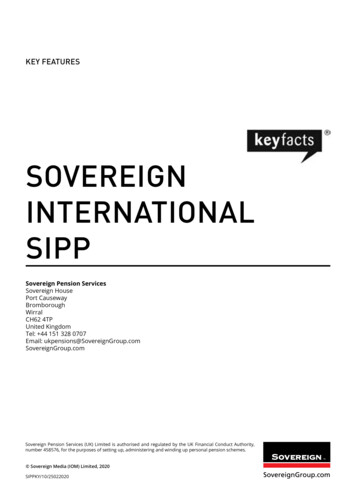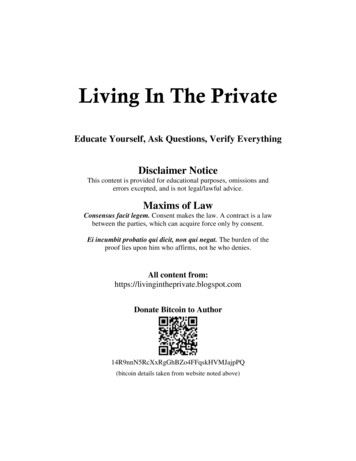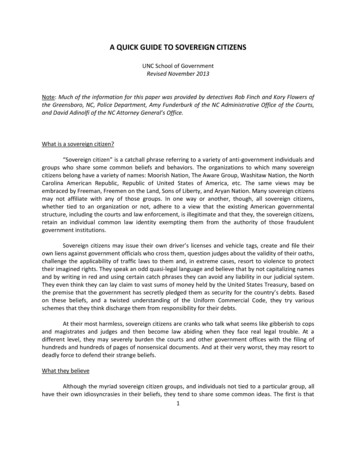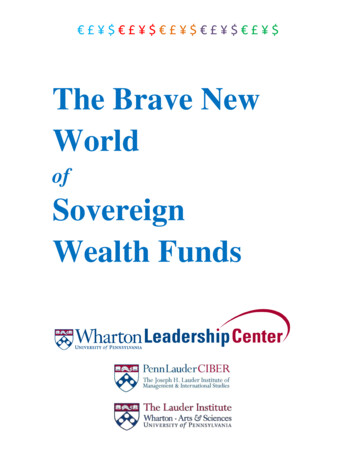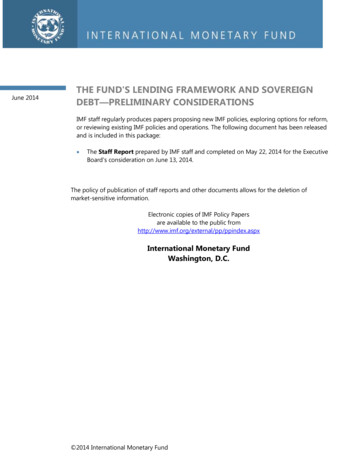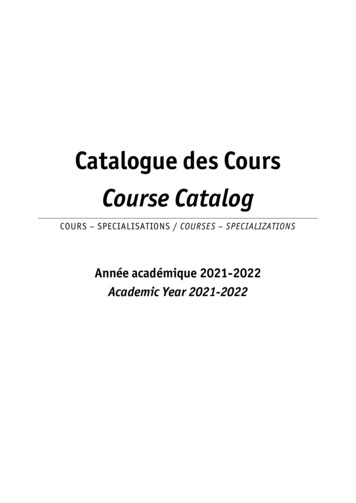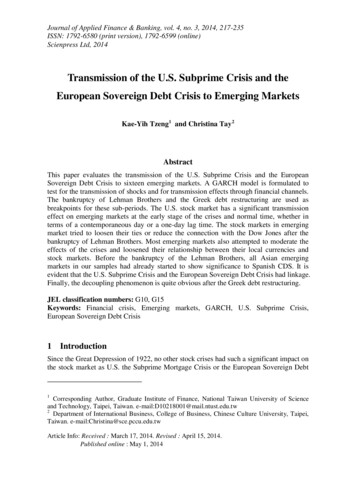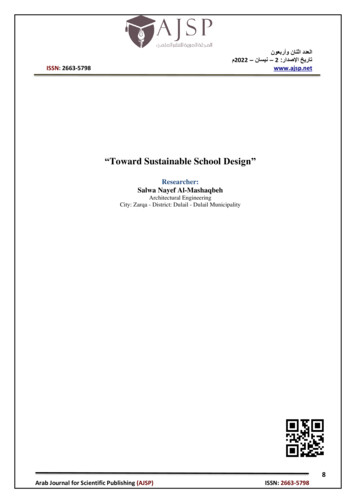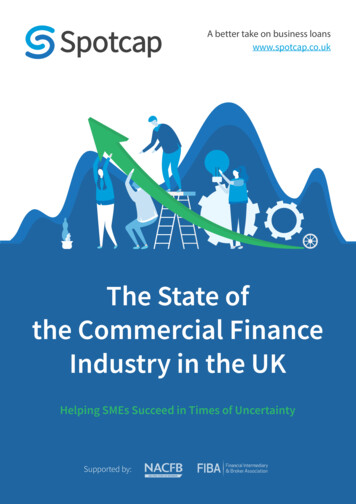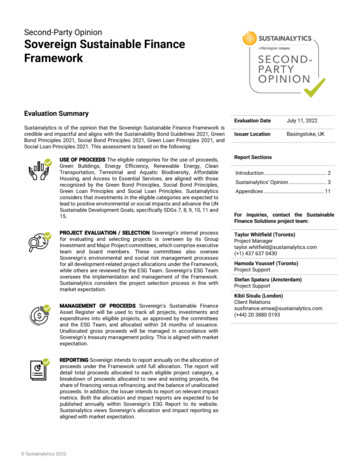
Transcription
Second-Party OpinionSovereign Sustainable FinanceFrameworkEvaluation SummarySustainalytics is of the opinion that the Sovereign Sustainable Finance Framework iscredible and impactful and aligns with the Sustainability Bond Guidelines 2021, GreenBond Principles 2021, Social Bond Principles 2021, Green Loan Principles 2021, andSocial Loan Principles 2021. This assessment is based on the following:Evaluation DateJuly 11, 2022Issuer LocationBasingstoke, UKThe eligible categories for the use of proceeds,Green Buildings, Energy Efficiency, Renewable Energy, CleanTransportation, Terrestrial and Aquatic Biodiversity, AffordableHousing, and Access to Essential Services, are aligned with thoserecognized by the Green Bond Principles, Social Bond Principles,Green Loan Principles and Social Loan Principles. Sustainalyticsconsiders that investments in the eligible categories are expected tolead to positive environmental or social impacts and advance the UNSustainable Development Goals, specifically SDGs 7, 8, 9, 10, 11 and15.Report SectionsSovereign’s internal processfor evaluating and selecting projects is overseen by its GroupInvestment and Major Project committees, which comprise executiveteam and board members. These committees also overseeSovereign’s environmental and social risk management processesfor all development-related project allocations under the Framework,while others are reviewed by the ESG Team. Sovereign’s ESG Teamoversees the implementation and management of the Framework.Sustainalytics considers the project selection process in line withmarket expectation.Taylor Whitfield (Toronto)Project Managertaylor.whitfield@sustainalytics.com( 1) 437 637 0430Sovereign’s Sustainable FinanceAsset Register will be used to track all projects, investments andexpenditures into eligible projects, as approved by the committeesand the ESG Team, and allocated within 24 months of issuance.Unallocated gross proceeds will be managed in accordance withSovereign’s treasury management policy. This is aligned with marketexpectation.Sovereign intends to report annually on the allocation ofproceeds under the Framework until full allocation. The report willdetail total proceeds allocated to each eligible project category, abreakdown of proceeds allocated to new and existing projects, theshare of financing versus refinancing, and the balance of unallocatedproceeds. In addition, the Issuer intends to report on relevant impactmetrics. Both the allocation and impact reports are expected to bepublished annually within Sovereign’s ESG Report to its website.Sustainalytics views Sovereign’s allocation and impact reporting asaligned with market expectation. Sustainalytics 2022Introduction . 2Sustainalytics’ Opinion . 3Appendices . 11For inquiries, contact the SustainableFinance Solutions project team:Hamoda Youssef (Toronto)Project SupportStefan Spataru (Amsterdam)Project SupportKibii Sisulu (London)Client Relationssusfinance.emea@sustainalytics.com( 44) 20 3880 0193
Second-Party OpinionSovereign Sustainable Finance FrameworkIntroductionSovereign Housing Association is a not-for-profit housing association which together with its subsidiarySovereign Housing Capital (“Sovereign” or the “Issuer”) provide social housing across south and south-westEngland. Headquartered in Basingstoke, UK, Sovereign owns and manages approximately 60,000 residentialunits.Sovereign has developed the Sovereign Sustainable Finance Framework (the “Framework”) under which itintends to facilitate the issuance of sustainability bonds, loans, private debt placements and revolving creditfacilities, and use the proceeds to finance and refinance, in whole or in part, existing and future affordablehousing, green buildings, energy efficiency, renewable energy, and clean transportation projects that areexpected to have a positive impact on the environment or social well-being of the communities in whichSovereign operates. The Framework defines eligibility criteria in seven areas:1.2.3.4.5.6.7.Green BuildingsEnergy EfficiencyRenewable EnergyClean TransportationTerrestrial and Aquatic BiodiversityAffordable HousingAccess to Essential ServicesSovereign engaged Sustainalytics to review the Sovereign Sustainable Finance Framework, dated June 2022,and provide a Second-Party Opinion on the Framework’s environmental and social credentials and itsalignment with the Sustainability Bond Guidelines 2021 (SBG), Green Bond Principles 2021 (GBP), Social BondPrinciples 2021 (SBP)1, Green Loan Principles 2021 (GLP) and Social Loan Principles 2021 (SLP)2. TheFramework has been published in a separate document.3Scope of work and limitations of Sustainalytics’ Second-Party OpinionSustainalytics’ Second-Party Opinion reflects Sustainalytics’ independent4 opinion on the alignment of thereviewed Framework with current market standards and the extent to which the eligible project categories arecredible and impactful.As part of the Second-Party Opinion, Sustainalytics assessed the following: The Framework’s alignment with the Sustainability Bond Guidelines 2021, Green Bond Principles2021, and Social Bond Principles 2021, as administered by ICMA, and the Green Loan Principles 2021and Social Loan Principles 2021, as administered by LMA, APLMA, and LSTA;The credibility and anticipated positive impacts of the use of proceeds; andThe alignment of the issuer’s sustainability strategy and performance and sustainability riskmanagement in relation to the use of proceeds.For the use of proceeds assessment, Sustainalytics relied on its internal taxonomy, version 1.11, which isinformed by market practice and Sustainalytics’ expertise as an ESG research provider.As part of this engagement, Sustainalytics held conversations with various members of Sovereign’smanagement team to understand the sustainability impact of their business processes and planned use ofproceeds, as well as management of proceeds and reporting aspects of the Framework. Sovereignrepresentatives have confirmed (1) they understand it is the sole responsibility of Sovereign to ensure thatthe information provided is complete, accurate or up to date; (2) that they have provided Sustainalytics withThe Sustainability Bond Guidelines, Green Bond Principles and Social Bond Principles are administered by the International Capital Market Associationand are available at 2 The Green Loan Principles and Social Loan Principles are administered by the Loan Market Association, Asia Pacific Loan Market Association andLoan Syndications and Trading Association and are available at: /# ples-slp/.3The Sovereign Sustainable Finance Framework is available on Sovereign Housing Association ’s website at: https://www.sovereign.org.uk/investors4 When operating multiple lines of business that serve a variety of client types, objective research is a cornerstone of Sustainalytics and ensuring analystindependence is paramount to producing objective, actionable research. Sustainalytics has therefore put in place a robust conflict managementframework that specifically addresses the need for analyst independence, consistency of process, structural separation of commercial and research (andengagement) teams, data protection and systems separation. Last but not the least, analyst compensation is not directly tied to specific commercialoutcomes. One of Sustainalytics’ hallmarks is integrity, another is transparency.12
Second-Party OpinionSovereign Sustainable Finance Frameworkall relevant information and (3) that any provided material information has been duly disclosed in a timelymanner. Sustainalytics also reviewed relevant public documents and non-public information.This document contains Sustainalytics’ opinion of the Framework and should be read in conjunction with thatFramework.Any update of the present Second-Party Opinion will be conducted according to the agreed engagementconditions between Sustainalytics and Sovereign.Sustainalytics’ Second-Party Opinion, while reflecting on the alignment of the Framework with marketstandards, is no guarantee of alignment nor warrants any alignment with future versions of relevant marketstandards. Furthermore, Sustainalytics’ Second-Party Opinion addresses the anticipated impacts of eligibleprojects expected to be financed with bond and loan proceeds but does not measure the actual impact. Themeasurement and reporting of the impact achieved through projects financed under the Framework is theresponsibility of the Framework owner. Upon twenty-four (24) months following the evaluation date set statedherein, Sovereign is encouraged to update the Framework, if necessary, and seek an update to the SecondParty Opinion to ensure ongoing alignment of the Framework with market standards and expectations.In addition, the Second-Party Opinion opines on the potential allocation of proceeds but does not guaranteethe realised allocation of the bond and loan proceeds towards eligible activities.No information provided by Sustainalytics under the present Second-Party Opinion shall be considered asbeing a statement, representation, warrant or argument, either in favour or against, the truthfulness, reliabilityor completeness of any facts or statements and related surrounding circumstances that Sovereign has madeavailable to Sustainalytics for the purpose of this Second-Party Opinion.Sustainalytics’ OpinionSection 1: Sustainalytics’ Opinion on the Sovereign Sustainable FinanceFrameworkSustainalytics is of the opinion that the Sovereign Sustainable Finance Framework is credible, impactful andaligns with the four core components of the GBP, SBP, GLP and SLP. Sustainalytics highlights the followingelements of the Framework: Use of Proceeds:- The eligible categories, Green Buildings, Energy Efficiency, Renewable Energy, CleanTransportation, Terrestrial and Aquatic Biodiversity, Affordable Housing, Access to EssentialServices, are aligned with those recognized by the GBP, SBP, GLP and SLP.- Under the Green Buildings category, Sovereign may finance the development, acquisition andconstruction of new buildings according to the following eligibility criteria: Buildings that have received at least an energy performance certificate (EPC) B orhigher.5 Buildings that have received a BREEAM certification of Excellent or better. Sustainalytics considers investments in green buildings that meet the above-describedstandards to be aligned with market expectation.- Within the Energy Efficiency category, the Issuer intends to finance the retrofit of existingbuildings to result in at least a two-level increase in its EPC to achieve a minimum C, or a onelevel increase to achieve A or B. Sovereign may also finance investments related to the purchaseand installation of technologies that aim to reduce energy consumption of properties, such assmart meters and smart thermostats, energy efficient household appliances, LED lighting, aswell as demand energy performance use monitoring and battery storage systems, including aspart of whole house retrofit pilot projects. Sovereign has indicated that no technologies financed under this category will be fossilfuel powered.As of April 2022, the energy performance of residential buildings with an EPC of B or higher was in the top 15% of properties in the UK. For moreinformation: ng-and-new-dwellings53
Second-Party OpinionSovereign Sustainable Finance FrameworkSustainalytics notes that each of the building performance improvement thresholdsoutlined in the Framework for this category represent an energy efficiencyimprovement of at least 30%. Whole house retrofit pilot projects means those improving on heating, renewableenergy generation and storage and digital controls that inform energy efficiency. Financed household appliances will fall into the highest two populated classes ofenergy efficiency in accordance with EU Regulation 2017/1369. Sustainalytics notesthat Sovereign’s reliance on EU energy labels to define eligibility in this category isconsistent with the EU Taxonomy Climate Delegated Act.Under the Renewable Energy category, Sovereign may invest in renewable energy generationprojects related to solar photovoltaic power, hot water panels and wind energy generation, eachoperating at a life cycle emissions intensity below 100 gCO2/kWh.Under the Clean Transportation category, the Issuer considers financing the installation oftechnology and infrastructure to facilitate access to zero emissions or public transportation,including electric vehicle charging points, cycling racks and cycle paths on Sovereigndevelopments, as well as the leasing or purchase of electric vehicles and hybrid vehicles forSovereign’s fleet that meet an emissions intensity threshold lower than 50 gCO2/km until 31December 2025, and zero emissions beginning 1 January 2026. Sustainalytics considers the expenditures under this category and the applicablethresholds specified in the Framework as aligned with market expectation.Under the Terrestrial and Aquatic Biodiversity Conservation category, Sovereign will financeexpenditures related to improving the biodiversity of land that is part of or in the vicinity ofSovereign developments. Specific expenditures may include flora and fauna preservation, themitigation of risks related to invasive species and the planting of trees and shrubbery. Biodiversity net gains resulting from activities under this category will be tracked usingthe Natural England Biodiversity Net-Gain Calculator Metric 3.0,6 with the goal ofachieving at least a 10% improvement in net biodiversity at each land development site.Sustainalytics notes that such biodiversity improvements are required under UK law forall new land developments, with enforcement beginning in November 2023.7Under the Affordable Housing category, Sovereign intends to finance projects in the UK involvingthe development, acquisition, construction and retrofit of social housing projects, supportinghome ownership, social and affordable home rentals, as well as other housing or shelter support. To support home ownership, Sovereign intends to target housing projects under the UKGovernment’s Shared Ownership Scheme.8 Under this scheme, households with anannual income of up to GBP 80,000 (or GBP 90,000 in London) or first-time buyers areeligible to purchase shares of homes, with the remaining ownership shares beingowned by a landlord. When facilitating the financing of home ownership under thisprogramme, the Issuer applies its own annual income threshold of GBP 60,000. InSustainalytics’ opinion, it is good practice for affordable housing programmes to targetlower-income segments of the population, or at least those earning below the medianincome. The Framework’s income cap of GBP 60,000 is well above the medianhousehold income in the UK, which was GBP 31,400 in FY202.9 Although Sovereign hasan income cap lower than that of the government scheme, and although the averageincome among Sovereign shared ownership customers was GBP 27,179 in 2021, theIssuer’s potential financing of households whose income levels can reach up to GBP60,000 is nonetheless a deviation from what Sustainalytics considers to be goodpractice for affordable housing programmes. For its social and affordable rental properties, Sovereign provides rental housing toindividuals placed on the housing register by a local authority. Eligibility for socialhousing in relation to household income levels is determined by the local authority, withrental pricing levels for both social and affordable rent governed nationally, reflecting ----Natural England, “The Biodiversity Metric 3.1 (JP039)”, at: ion/6049804846366720UK Public General Acts, “Environmental Act – 2021”, at: ed8 UK Government, “Shared Ownership”, at: ship/9 UK Government, Office for National Statistics, “Average household income, UK: financial year 2021”, inancialyearending2021674
Second-Party OpinionSovereign Sustainable Finance Framework 10local and regional market rent levels and incorporating various adjustments applied perthe Ministry of Housing Communities & Local Government. Sustainalytics notes thatsocial and affordable housing is characterized by rents of up to a maximum of 80% ofthe area market rental rate, with social housing having rents generally limited to 60%of market rental rates10. These housing programs are considered to be aligned withmarket practice. Sovereign will finance the provision of shelter services for marginalized anddisadvantaged groups, including people with disabilities, homeless individuals, seniorsand victims of domestic violence. These services will be made accessible to allregardless of ability to pay. Sustainalytics considers the financing of these activities asexpected to provide social benefits and be aligned with best practice.- Under the Access to Essential Services category, the Issuer may finance the provision ofcustomer support schemes and services that facilitate health, well-being and communityengagement for the residents of its affordable housing developments, including financialsupport services, entrepreneurial support and career skill development, digital inclusion trainingand equipment, and mental and physical health support. Sovereign has confirmed that thesesupport services will be made accessible to all regardless of ability to pay. Financial support services will consist of advice on the topics of debt relief andpersonal finance. Projects to support digital inclusion will consist of skill trainings and developmentprograms to the target population. Sustainalytics considers enhancing access to publicand free education as socially impactful and aligned with best practice. Support services provided by external agency health and well-being professionals. Sustainalytics considers the financing of these activities as expected to provide socialbenefits and to be aligned with best practice.Project Evaluation and Selection:- Sovereign has in place internal processes for the evaluation and selection of projects by itsGroup Investment Committee (IC), which is comprised of the CEO, the CFO as the Chair, the COOand the Executive Director of Development and Commercial. This committee has beendelegated its authority by the board of directors. For larger and complex projects, the evaluation,selection and monitoring processes are carried out by Sovereign’s Major Project Committee(MPC), which is comprised of two non-executive directors who are also board members, and upto one additional independent member. Further, the implementation and management of theFramework is carried out by Sovereign’s ESG Team, comprised of the CFO, Treasury team, andthe Construction and Technical Director, who ensures alignment of all projects with the Issuer’scorporate plan and its key standards.- Project selection carried out by the committees involves the review of any reportedenvironmental and social risks associated with investments to ensure all projects areappropriately managed and mitigated, and progress in compliance with relevant laws, standardsand regulations. Sustainalytics considers these environmental and social risk managementsystems to be adequate.- Based on the establishment of cross-functional project selection committees that involve boardoversight, as well as the Framework-specific oversight carried out by the ESG team,Sustainalytics considers this process to be in line with market expectation.Management of Proceeds:- The gross proceeds from any issuance under the Framework will be allocated into the Issuer’smain receipts account, where the ESG Team will track and monitor an equivalent amount usinginternal reporting system until full allocation.- Sovereign’s Sustainable Finance Asset Register will be used to track all projects, investmentsand expenditures into eligible projects, as approved by the committees and the ESG Team, andallocated within 24 months of issuance. It will also be ensured by the relevant oversight bodiesthat the amounts allocated to financed projects is, subject to initially achieving full allocation, atall times equal to or in excess of the gross proceeds outstanding from the Framework’sissuances while the relevant instrument remains outstanding.UK Parliament – House of Commons Library, “What is affordable housing?”, at: fings/cbp-7747/5
Second-Party OpinionSovereign Sustainable Finance FrameworkUnallocated gross proceeds will be managed in accordance with Sovereign’s TreasuryManagement Policy, held in cash deposits, GBP denominated money market funds, or ESGbonds and deposits. This process ensures that the proceeds will not be used at any time to fundinvestments that support activities in the fossil fuel, nuclear weapons, defence, alcohol, tobaccoor gambling industries.- Based on the timeframe for full allocation and the disclosure of temporary allocation ofproceeds, Sustainalytics considers this process to be in line with market expectation.Reporting:- Sovereign will report annually on the allocation of proceeds from any sustainable financeinstruments issued under the Framework until all proceeds have been fully allocated, and whenmaterial reallocations of proceeds have taken place during the life of an outstanding instrument.- The report will detail total proceeds allocated to each eligible project category. It will also includea breakdown of proceeds allocated to new and existing projects, the share of financing versusrefinancing and the balance of unallocated proceeds.- Impact reporting will include indicators such as the number of newly completed buildingsmeeting the outlined green building criteria, the number of properties retrofitted for energyefficiency and the achieved EPC band, installed renewable energy capacity, low or zero emissionvehicles as a percentage of the total fleet, and the number of financed affordable homes.- Allocation and impact reports will be made available in the Issuer’s ESG report, which ispublished annually on its website.- Based on the commitment to allocation and impact reporting, Sustainalytics considers thisprocess to be in line with market expectation.- Alignment with Sustainability Bond Guidelines 2021Sustainalytics has determined that the Sovereign Sustainable Finance Framework aligns with the four corecomponents of the GBP, SBP, GLP and SLP. For detailed information, please refer to Appendix 1: SustainabilityBond/ Sustainability Bond Programme External Review Form.Section 2: Sustainability Strategy of SovereignContribution of Framework to Sovereign Housing Association ’s sustainability strategySustainalytics is of the opinion that Sovereign demonstrates a commitment to sustainability through itssustainability strategy that is based on three connected pillars: (i) societal impacts; (ii) natural environmentimpacts; and (iii) impacts on the housing system.11 Sovereign is also aligned with The Good Economy’sSustainability Reporting Standard (SRS) for social housing, which aims to align with the relevant socialhousing principles of the SDGs and those of the International Capital Market Association (ICMA),Sustainability Accounting Standards Board (SASB), Global Reporting Initiative (GRI) and the Task-Force onClimate Related Financial Disclosures (TCFD).12 Sovereign reports on ESG issues following SRS’s proposedset of 12 themes that are divided into 48 criteria. In line with its first sustainability strategy pillar, Sovereign supports its customers in the transition tolow-carbon energy by providing energy switching initiatives and advice through its partner PocketPower, a social enterprise dedicated to helping individuals save money, with a focus on low-incomefamilies. Sovereign also guides its customers on sustainable living practices through an educationalprogramme. Moreover, the Issuer provides community support, financial and digital support andtraining, and work-related advice and training to help in maintaining jobs during the COVID-19pandemic. The Issuer is involved in increasing employment by being part of the UK government’sKickstart Scheme, by being in the partnership programme Skills 4 Work, and by offering residentgrants for training, work, business start-ups and childcare while working.13 In FY 2020/21, SovereignSovereign Housing Association, “ESG Report 2021”, at: 73b6fdc4f960/ESG%20Report%202021.pdf12 The Good Economy, ESG Social Housing Working Group, “The Sustainability Reporting Standard for Social Housing”, (2020), SRS final-report 2020-11-16-094356.pdf13Sovereign Housing Association has provided Sustainalytics with the document: “Thriving Communities – Creating opportunities for all”116
Second-Party OpinionSovereign Sustainable Finance Framework reported investments of GBP 4.72 million, generating a corresponding social value of overGBP 24 million.14,15In terms of impact on the natural environment, Sovereign has committed to implementingbiodiversity management practices, including scoring the net biodiversity gains of eachdevelopment, and the setting of a minimum threshold for brownfield developments of 25% of newprojects, and 35% when estate regeneration and mixed-use urban regeneration projects are takeninto consideration. Further, the Issuer has committed to the continued procurement of 100% of itsoperational energy from renewable sources. By 2026, Sovereign has also committed to developinga pathway to net zero carbon emissions for existing homes, including a target of building exclusivelynet zero ready new homes. Further, the Issuer targets an increase in the energy efficiency of all itshomes to above EPC C by 2035 and to have Standard Assessment Procedure (SAP) scores greaterthan 86 points for all homes by 2047.16,17,18To approach the last strategic pillar, Sovereign plans on growing its output of affordable homes bybuilding 2,400 homes per year, starting on FY 2026/27. In FY 2020/21 the Issuer completed theconstruction of 1,051 new homes, of which 45% represent shared ownership, 41% affordable rentand 14% social rent.19 The Issuer also plans on researching methods of developing town centres bycreating mixed-use sites combining affordable housing with retail. By 2026, Sovereign plans to bedeveloping a minimum of two schemes for mixed housing and retail.20,21Sustainalytics is of the opinion that the Sovereign Sustainable Finance Framework is aligned with the Issuer’soverall sustainability strategy and initiatives and will further the Issuer’s action on its key sustainabilitypriorities.Approach to managing environmental and social risks associated with the projectsSustainalytics recognizes that the use of proceeds of issuances under the Framework will be directed towardseligible projects that are expected to have positive environmental and social impacts. However, Sustainalyticsis aware that such eligible projects could also lead to negative environmental and social outcomes. Some keyenvironmental and social risks possibly associated with the eligible projects could affect employeeoccupational health and safety, stakeholder participation and community engagement, and emissions andwaste generated during construction.Sustainalytics is of the opinion that Sovereign is able to manage and mitigate potential risks throughimplementation of the following: To address the occupational health and safety risks, Sovereign has in place its Health and SafetyPolicy, which aims to protect employees, residents and contractors in its operations. To assure thepolicy’s implementation, the Issuer has put in place a management system containing proceduresand guidance in line with the Safety Services Strategy 2019-2024.22Sovereign addresses stakeholder rights and community engagement through its Resident and BoardPartnership (RBP), which allows customers to participate in the development of Sovereign’s strategy,policies and service standards. Moreover, Sovereign has adopted the National Housing FederationSovereign Housing Association, “ESG Report 2021”, at: 73b6fdc4f960/ESG%20Report%202021.pdf15 Sovereign Housing Association, “Corporate Plan 2021-2026”, at: 2026%20V1.pdf16 SAP is the methodology used to assess a dwelling’s environmental performance. The SAP underpins EPC, as the SAP scores form the EPCs.17 Sovereign Housing Association, “ESG Report 2021”, at: 73b6fdc4f960/ESG%20Report%202021.pdf18 Sovereign Housing Association, “Corporate Plan 2021-2026”, at: 2026%20V1.pdf19 According to the UK Regulator of Social Housing, the affordable rent for a new tenancy is allowed to be 80% of the market rent, while the social rent canbe a maximum of 10% of the formula rent. More information available at: https://www.gov.uk/government/publica
and Social Loan Principles 2021, as administered by LMA, APLMA, and LSTA; The credibility and anticipated positive impacts of the use of proceeds; and The alignment of the issuer's sustainability strategy and performance and sustainability risk management in relation to the use of proceeds.
